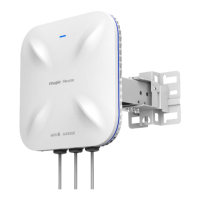Hardware Installation and Reference Guide Product Overview
6
2.4 GHz: 1148 Mbps
5 GHz: 4804 Mbps
OFDM: BPSK@6/9 Mbps, QPSK@12/18 Mbps, 16QAM@24 Mbps, 64QAM@48/54
Mbps
DSSS: DBPSK@1 Mbps, DQPSK@2 Mbps, and CCK@5.5/11 Mbps
MIMO-OFDM: BPSK, QPSK, 16QAM, 64QAM, 256QAM and 1024QAM
OFDMA
11b: –96 dBm (1 Mbps), –93 dBm (5 Mbps), –89 dBm (11 Mbps)
11a/g: –91 dBm (6 Mbps), –85 dBm(24Mbps), –80 dBm (36 Mbps), –74 dBm ( 54
Mbps)
11n: –90 dBm (MCS0), –70 dBm (MCS7), –89 dBm (MCS8), –68 dBm (MCS15)
11ac: 20 MHz: –88 dBm (MCS0), –63 dBm (MCS9)
11ac: 40 MHz: –85 dBm (MCS0), –60 dBm (MCS9)
11ac: 80 MHz: –85 dBm (MCS0), –60 dBm (MCS9)
11ax: 80 MHz: –82 dBm (MCS0), –57 dBm (MCS9), –52 dBm (MCS11)
11ax: 160 MHz: –75 dBm (MCS0), –55 dBm (MCS9), –50 dBm (MCS11)
Note: The transmit power is country-specific.
Configurable in increments of 1 dBm
300 mm × 300 mm × 75.5 mm (11.81 in. x 11.81 in. x 2.97 in., without the mounting
plate)
≤ 3.5 kg (7.72 lbs., without the mounting plate)
One 100/1000/2500Base-T Ethernet port, PoE-capable
One 1000Base-X SFP port (The SFP transceiver is an optional accessory.)
Note: The access point itself does not transmit optical signals. An optical transceiver
module must be installed on the access point to convert optical signals into electrical
signals.
There are three power supply modes available:

